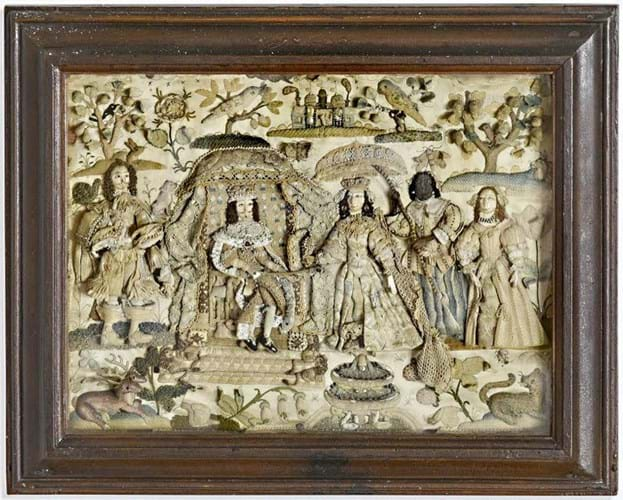Lot 312 at the Dreweatts white glove sale on October 4 was catalogued as possibly depicting Charles II (1630- 83) meeting his bride Catherine of Braganza (1638- 1705). Though the composition was not unusual, the inclusion of a black attendant was. She holds a parasol above Catherine that is dated 1669 with seed pearls.
It was hammered down for £24,000 to Mark Pargeter of Alexander George Antiques, a furniture specialist trading from Buscot Manor, Oxfordshire. He is now offering the panel for a six-figure sum and said it was “overlooked for its outstanding cultural significance and historical importance. You could say it was hiding in plain sight”.
In his research, he has considered the identity of the various subjects and symbols in the work. On the far left he has identified Prince Rupert of the Rhine (1619-82) with his white poodle - and alleged spirit familiar - Boy on his shoulder. On the far right he suggests it depicts Sophia of Hanover (1630-58), mother of George I.
Much of the symbolism revolves around fertility, he added, with Charles’ sceptre pointing at his wife’s womb, the parasol representing divine protection and the dragonfly above her attendant’s head representing change and transformation. All these auspicious signs were ultimately in vain, as the pair never had children.
Pargeter also considered another image of a British 17th century black subject which was recently on the market. The c.1650 portrait, which sold at Trevanion in 2021 and was blocked from export before being bought by Compton Verney (ATG no 2599), showed two women: one black and one white, seated next to each other as equals in fashionable dress, with equally modish face patches.
Pargeter sees two potential links to the stumpwork. One is the identity of the maker, who in both cases he suggests could be Princess Louise Hollandine (1622-1709), a painter and proficient in various artistic pursuits.
The other connection could be the black sitter. In the painting Pargeter says: “She has long hands and fingers and the same shape face and nose as that of Charles II. Was she one of his illegitimate children?”
He added that in the 17th century he believed only 17 black people were recorded living in London, among them Rebecca Blackmore, an arms painter: “Could she be the mother of the black lady depicted in the stump work?”
















